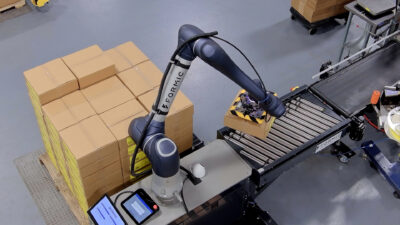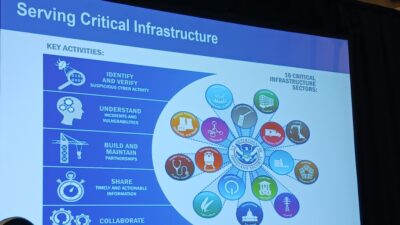COVID-19 is forcing manufacturers to rely more on automation and digitalization for long-term operations to reduce the financial impact from epidemics and other potential economic challenges.

The COVID-19 outbreak is becoming a global stress test. As the number of people infected with the virus continues to rise around the world, uncertainties about global economic growth increase. China hosted the first outbreak and, after more than 1 month of unprecedentedly strict prevention and control measures, the epidemic has been essentially brought under control. Now the whole nation’s focus is shifting to the recovery of normal ways of production and normal lifestyles. Even as the outbreak subsides, there are some major short- and l0ng-term effects the Chinese manufacturing industry is feeling, which will carry over to other countries.
For many of the infected regions, the economy will fall sharply in the short term, and then rebound after the epidemic is over, but COVID-19 is unlikely to have a huge long-term impact. Epidemic prevention and control measures from local governments will be a key factor.
In February 2020, China’s manufacturing purchasing manager index (PMI) was 35.7%, down 14.3 percentage points from the previous month. Meanwhile, the Production Index was 27.8%, down by 23.5 percentage points from the previous month, indicating that manufacturing production activity had slowed down radically. As outbreaks continue to unfold around the world, external demand will falter, further hampering recovery.
According to analysis of data segments such as power generation, population migration, and transportation; the work resumption rate in China is about 65% (except for students). Although the overall recovery of enterprises is better, it is more difficult for small and medium-sized enterprises and lifestyle-service industries to return to work. It is expected that production and operation will get back to normal completely by May.
The effect of local government’s prevention and control of the epidemic is the key variable and the most decisive factor. On the premise of effective prevention and control, the whole epidemic will be over in 2-3 months, and societies will return to normal.
COVID-19 may have a far-reaching impact on the capacity layout and supply chain network of many enterprises. Multinational enterprises in particular will further improve their disaster emergency mechanisms and supply chain management.
Many enterprises will now be thinking about relocating manufacturing. During the 2011 earthquake in Japan, even companies who were hardly hit by supply chain issues decided to relocate. However, cross-border relocation of production capacity is not an easy decision to make, and many factors need to be taken into account, such as local market capacity, time and investment required, local government policies, infrastructure and logistics, labour costs, skill levels and so on. Relatively speaking, the completeness of China’s supply chain in automobile, electronics and other industries makes the Chinese industrial chain very efficient and flexible. This, coupled with China’s huge domestic market, stable government policies, strong infrastructure, good labour skills and engineering resources, means that many global companies will surely want to maintain key production centers in China.
The establishment of robust disaster management mechanisms may well be a better alternative than moving production, for many companies. And, in harsh times, measures such as reallocation of production capacity and inventory to different regions, backed-up with a policy of using similar products as substitutes in the short-run, and the development of multi-point suppliers, are all possible solutions. Although the above will undoubtedly increase costs, it will better protect supply chain stability – potentially delivering great savings in the next crisis.
In the long run, the establishment of information chains will further enhance the resilience of supply networks. Key information about materials, logistics, inventory, production and capital in the supply chain can easily be grasped, analyzed and shared to improve overall supply chain management. At the same time, market demand can be tracked and predicted more dynamically, and production rhythms can be adjusted accordingly. All this needs to be part of a wider digitalization push from the manufacturing industry to deal with the next crisis.
For manufacturing enterprises, the epidemic has simply exposed problems and risks that already existed. As such, it might force industry to undertake much needed reforms to automation, digitalization and logistics processes and systems.
For manufacturing enterprises, the short-term impact of the epidemic is a decline in revenue and profits. For example, under China’s stringent prevention and control measures, a large number of manufacturing enterprises were completely suspended, and the loss of production capacity is expected to be 1 to 3 months in total. In addition, production recovery cannot be achieved overnight, and the resumption of work may also face difficulties in the form of recruitment problems, an insufficient supply of raw materials, and other issues such as logistics and cash flow. Operating costs will also clearly remain high during this period, further eroding profit.
Small and medium-sized enterprises, and those with insufficient cash flow, will feel the pressure most. For enterprises with good operation and high capacity utilization, the focus must be to restore production as soon as possible, but for some enterprises that were on the edge of the market, the epidemic will push them over that edge.
It has been apparent for some time that, as Southeast Asia continues to take an increasingly large amount of the world’s low-value-added production, China’s manufacturing enterprises need to upgrade to higher-value activities. If the pandemic causes a general move to higher levels of automation, this will further that long-term goal.
The COVID-19 epidemic has brought unexpected difficulties and challenges to governments, industries and enterprises around the world. But it is a short-term effect and it will eventually pass. In the long run, COVID-19 is a chance for industries to make much-needed operational improvements.
Learn more about the effects of COVID-19 on Chinese and global manufacturing here.



